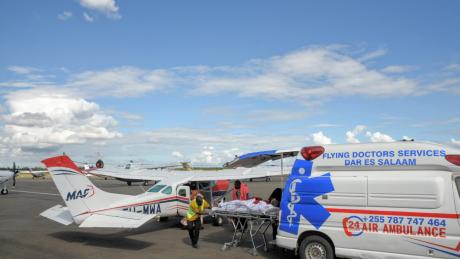
The lives of a pregnant woman and her baby were saved when MAF flew them to a Tanzanian hospital for emergency care
Pendo (her name has been changed to protect her privacy) was only 25 weeks pregnant when the doctors noticed a loss in the amniotic fluid during a routine check-up at Haydom Hospital and immediately recommended more specialised care to save the pregnancy.
The Haydom Hospital reached out to the MAF office and requested an immediate medevac. Pilot Peter Griffin took off from Arusha Airport for an hour’s flight to Haydom airstrip, ready for the medevac. The medical team was on standby with the patient ready on a stretcher.
With the help of the medical team, Pendo was loaded safely into the Cessna 206 aircraft in the company of a nurse from Haydom Hospital to monitor her condition throughout the flight.
Oligohydramnios occurs during pregnancy when the amniotic fluid is lower than expected during the baby’s gestational age. Amniotic fluid is a water-like fluid that surrounds a baby in the uterus. It protects the baby from infection and umbilical cord compression and cushions their movements while they’re in the uterus. Too little amniotic fluid can cause health problems in a baby or be a sign of an underlying condition. These conditions could affect a baby’s development or cause complications during labour and delivery.
The weather was not in their favour as clouds were gathering quickly but Peter managed to fly at a high altitude to avoid the bad weather and turbulence offering Pendo a smooth journey. Upon arrival at the Arusha airport, the hospital ambulance was in waiting ready to transport Pendo to Arusha Lutheran Medical Centre to receive specialised care. The nurse briefed the ALMC medical team about Pendo’s situation and the care that had been administered at Haydom Hospital.
The Neonatal Intensive Care Unit (NICU) at ALMC was developed by Dr Steven Swanson, the current Medical Director of the NICU. His medical team welcomed Pendo to their care, and she was immediately whisked into the theatre for an emergency C-section and a healthy baby was delivered.
Both the lives of the mother and the child were rescued through this medical evacuation flight. One week later, Pendo was recovering well through postoperative care and her child was under incubation and observation until they reached 36 weeks or more so that they could go home.
The MAF-facilitated medevacs have helped save the lives of many isolated people by beating three hours of travel on impassable roads that could risk their lives. By air, it is just an hour’s flight to the right medical facility. With every moment vital in a medevac, MAF pilot Peter Griffin said the nurse accompanying the patient was impressed that his flight time estimate was so accurate.

"I was asked by the nurse how long the flight was going to take and after considering the weather and circumstances affecting the flight, I answered him that we would be in Arusha in one hour,” Peter said.
“Upon landing at Arusha airport, the nurse told me he was very impressed as the flight took exactly one hour - not a minute over or under! With medevac flights we are pressed with time as the urgency of our travel is evident by the patient on board."
Mother and baby were doing well but are expected to remain in the hospital for a few weeks for monitoring.
With medevac flights we are pressed with time as the urgency of our travel is evident by the patient on board.